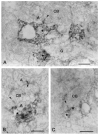Localization of neuropeptide Y1 receptor immunoreactivity in the rat retina and the synaptic connectivity of Y1 immunoreactive cells
- PMID: 12455004
- PMCID: PMC3696015
- DOI: 10.1002/cne.10423
Localization of neuropeptide Y1 receptor immunoreactivity in the rat retina and the synaptic connectivity of Y1 immunoreactive cells
Abstract
Neuropeptide Y (NPY), an inhibitory neuropeptide expressed by a moderately dense population of wide-field amacrine cells in the rat retina, acts through multiple (Y1-y6) G-protein-coupled receptors. This study determined the cellular localization of Y1 receptors and the synaptic connectivity of Y1 processes in the inner plexiform layer (IPL) of the rat retina. Specific Y1 immunoreactivity was localized to horizontal cell bodies in the distal inner nuclear layer and their processes in the outer plexiform layer. Immunoreactivity was also prominent in cell processes located in strata 2 and 4, and puncta in strata 4 and 5 of the IPL. Double-label immunohistochemical experiments with calbindin, a horizontal cell marker, confirmed Y1 immunostaining in all horizontal cells. Double-label immunohistochemical experiments, using antibodies to choline acetyltransferase and vesicular acetylcholine transporter to label cholinergic amacrine cell processes, demonstrated that Y1 immunoreactivity in strata 2 and 4 of the IPL was localized to cholinergic amacrine cell processes. Electron microscopic studies of the inner retina showed that Y1-immunostained amacrine cell processes and puncta received synaptic inputs from unlabeled amacrine cell processes (65.2%) and bipolar cell axon terminals (34.8%). Y1-immunoreactive amacrine cell processes most frequently formed synaptic outputs onto unlabeled amacrine cell processes (34.0%) and ganglion cell dendrites (54.1%). NPY immunoreactivity in the rat retina is distributed primarily to strata 1 and 5 of the IPL, and the present findings, thus, suggest that NPY acts in a paracrine manner on Y1 receptors to influence both horizontal and amacrine cells.
Copyright 2002 Wiley-Liss, Inc.
Figures










Similar articles
-
Distribution and synaptic connectivity of neuropeptide Y-immunoreactive amacrine cells in the rat retina.J Comp Neurol. 2002 May 6;446(3):219-34. doi: 10.1002/cne.10184. J Comp Neurol. 2002. PMID: 11932938
-
Light and electron microscopical analysis of nitric oxide synthase-like immunoreactive neurons in the rat retina.Vis Neurosci. 1999 Mar-Apr;16(2):379-89. doi: 10.1017/s0952523899162175. Vis Neurosci. 1999. PMID: 10367971
-
Vesicular gamma-aminobutyric acid transporter expression in amacrine and horizontal cells.J Comp Neurol. 2002 Apr 8;445(3):227-37. doi: 10.1002/cne.10166. J Comp Neurol. 2002. PMID: 11920703 Free PMC article.
-
Somatostatin and somatostatin subtype 2A expression in the mammalian retina.Microsc Res Tech. 2000 Jul 15;50(2):103-11. doi: 10.1002/1097-0029(20000715)50:2<103::AID-JEMT2>3.0.CO;2-X. Microsc Res Tech. 2000. PMID: 10891874 Review.
-
Emerging novel roles of neuropeptide Y in the retina: from neuromodulation to neuroprotection.Prog Neurobiol. 2014 Jan;112:70-9. doi: 10.1016/j.pneurobio.2013.10.002. Epub 2013 Oct 30. Prog Neurobiol. 2014. PMID: 24184719 Review.
Cited by
-
Prognostic and Functional Analysis of NPY6R in Uveal Melanoma Using Bioinformatics.Dis Markers. 2022 Apr 8;2022:4143447. doi: 10.1155/2022/4143447. eCollection 2022. Dis Markers. 2022. PMID: 35432628 Free PMC article.
-
Activation of Neuropeptide Y Receptors Modulates Retinal Ganglion Cell Physiology and Exerts Neuroprotective Actions In Vitro.ASN Neuro. 2015 Aug 26;7(4):1759091415598292. doi: 10.1177/1759091415598292. Print 2015 Jul-Aug. ASN Neuro. 2015. PMID: 26311075 Free PMC article.
References
-
- Ammar DA, Hughes BA, Thompson DA. Neuropeptide Y and the retinal pigment epithelium: receptor subtypes, signaling, and bioelectrical responses. Invest Ophthalmol Vis Sci. 1998;39:1870–1878. - PubMed
-
- Arvidsson U, Riedl M, Elde R, Meister B. Vesicular acetylcholine transporter (VAChT) protein: a novel and unique marker for cholinergic neurons in the central and peripheral nervous systems. J Comp Neurol. 1997;378:454–467. - PubMed
-
- Balasubramaniam AA. Neuropeptide Y family of hormones: receptor subtypes and antagonists. Peptides. 1997;18:445–457. - PubMed
-
- Blomqvist AG, Herzog H. Y-receptor subtypes: how many more? Trends Biol Sci. 1997;20:294–298. - PubMed
Publication types
MeSH terms
Substances
Grants and funding
LinkOut - more resources
Full Text Sources
Research Materials
Miscellaneous

